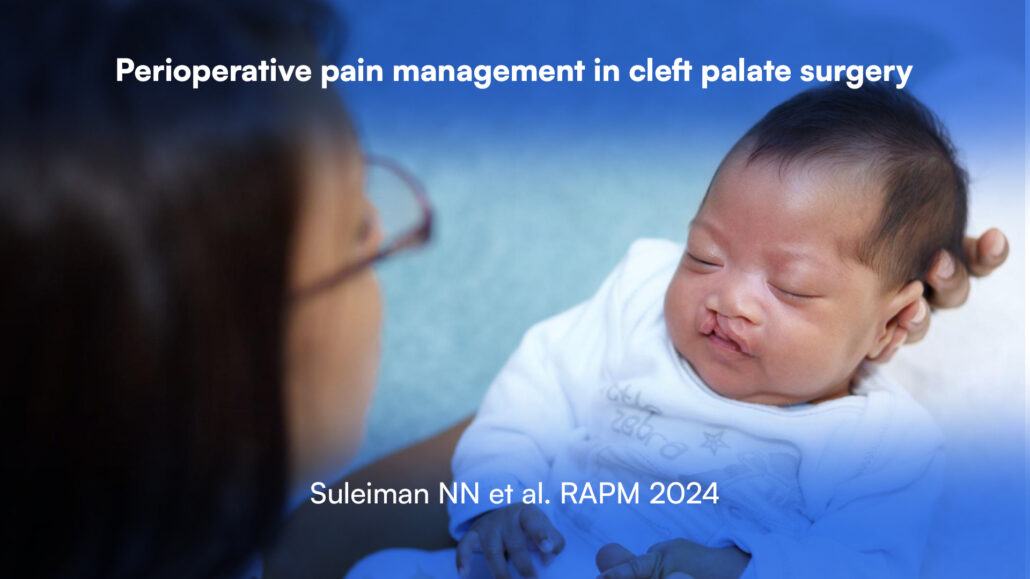
Perioperative pain management in cleft palate surgery
Cleft palate surgery is a crucial procedure aimed at correcting one of the most common congenital birth defects. However, it is often associated with significant postoperative pain. An effective perioperative pain management strategy is essential for ensuring optimal recovery, minimizing complications, and improving patient outcomes. Below is an in-depth review based on the latest findings and recommendations from a systematic review published in Regional Anesthesia & Pain Medicine (RAPM).
Introduction
Cleft palate surgery not only addresses functional impairments such as speech, hearing, and dentition but also significantly enhances psychosocial development. However, postoperative pain management remains a challenge due to the limited procedure-specific evidence and difficulties in pain assessment in pediatric patients.
Key objectives of the review
The review aimed to:
- Evaluate existing evidence on pain management strategies for cleft palate surgery.
- Develop procedure-specific recommendations using the PROcedure-SPECific postoperative pain managemenT (PROSPECT) methodology.
Summary of findings
The review analyzed data from various randomized controlled trials (RCTs) and systematic reviews published from July 2002 to August 2023. Out of 1048 studies initially identified, 23 met the inclusion criteria, focusing exclusively on pediatric populations. Major findings include:
- Suprazygomatic maxillary nerve block: This was found effective in reducing postoperative pain and opioid consumption when performed pre-incision.
- Palatal nerve block: An alternative when the maxillary nerve block is not feasible but with higher opioid consumption.
- Dexmedetomidine: Recommended as an adjunct to local anesthetics for nerve blocks, enhancing and prolonging analgesia.
Recommendations for perioperative pain management
Preoperative and intraoperative pain management
- Basic analgesic regimen: Includes acetaminophen and nonsteroidal anti-inflammatory drugs (NSAIDs) or cyclooxygenase-2 (COX-2) inhibitors, administered preoperatively and intraoperatively.
- Nerve blocks: A pre-incisional suprazygomatic maxillary nerve block is preferred. If unavailable, a palatal nerve block should be administered.
- Adjuvants: Dexmedetomidine can be used as an additive for nerve blocks or administered intravenously if not used as an additive.
Postoperative pain management
- Scheduled analgesic dosing: Continued use of acetaminophen and NSAIDs or COX-2 inhibitors postoperatively on a round-the-clock basis.
- Opioids: Reserved for rescue analgesia if the initial pain management strategy is inadequate.
Specific analgesic techniques explored
- Suprazygomatic maxillary nerve block:
- Found to be effective when combined with dexmedetomidine.
- Recommended due to its ability to significantly reduce postoperative pain and opioid usage.
- Palatal nerve block:
- Although effective, it is associated with higher opioid consumption compared to the maxillary nerve block.
- Recommended only when maxillary nerve blocks are not feasible due to anatomical or technical constraints.
- Dexmedetomidine:
- Proven effective as an adjuvant for both suprazygomatic maxillary and palatal nerve blocks.
- Extends analgesia duration but must be monitored for side effects like bradycardia and hypotension.
- Local infiltration:
- Studies show mixed results; while ropivacaine provided effective pain relief in some cases, its effectiveness remains inconsistent.
Non-recommended interventions
- Sphenopalatine ganglion block: Lack of procedure-specific evidence.
- Clonidine and ketamine local infiltration: Insufficient data to support their effectiveness.
- IV lidocaine and propofol: No clear benefit for cleft palate surgery-specific pain management.
Pain assessment in pediatric populations
- Pain assessment tools for young children, such as the Face, Legs, Activity, Cry, Consolability (FLACC) scale, are recommended but may be influenced by non-pain factors such as fear and agitation.
- Objective measures like postoperative analgesic consumption are suggested for better evaluation in clinical trials.
Why this guideline was developed
Cleft palate surgery poses significant postoperative pain challenges that, if not managed effectively, can impact surgical outcomes, such as increasing the risk of wound dehiscence and prolonging hospital stays. The PROSPECT guidelines aim to provide evidence-based, procedure-specific recommendations to improve outcomes.
Step-by-step guide to optimal pain management
- Preoperative preparation:
- Administer acetaminophen and NSAIDs as part of a basic analgesic regimen.
- Perform a suprazygomatic maxillary nerve block if possible.
- Intraoperative care:
- Continue with NSAIDs and consider adding dexmedetomidine to the nerve block for prolonged analgesia.
- Postoperative care:
- Maintain round-the-clock dosing of basic analgesics.
- Monitor for pain levels and administer opioids only if necessary.
Future research and limitations
The review highlights the need for further high-quality RCTs to address gaps in procedure-specific evidence, particularly for interventions like local anesthetic infiltration and the use of dexamethasone. Moreover, standardization of pain assessment methods is critical for enhancing trial outcomes in pediatric populations.
Conclusion
The PROSPECT guidelines offer a robust framework for managing perioperative pain in cleft palate surgery. By implementing these evidence-based recommendations, clinicians can optimize patient care, reduce opioid usage, and improve overall recovery outcomes for children undergoing this vital procedure.
This comprehensive, procedure-specific approach marks a significant advancement in the standard of care for cleft palate surgery, ensuring that children receive the most effective and safest pain management available.
For more detailed information, refer to the full article in RAPM.
Suleiman NN, Luedi MM, Joshi G, et al. Perioperative pain management for cleft palate surgery: a systematic review and procedure-specific postoperative pain management (PROSPECT) recommendations. Reg Anesth Pain Med. 2024;49(9):635-641.
Explore this topic and many more with NYSORA’s Anesthesia Updates 2025, filled with engaging questions to expand your knowledge. Don’t miss out—get your copy on Amazon or Google Books.



